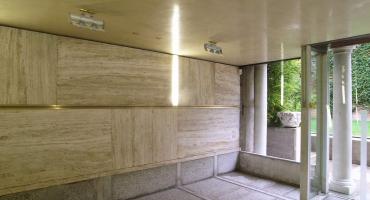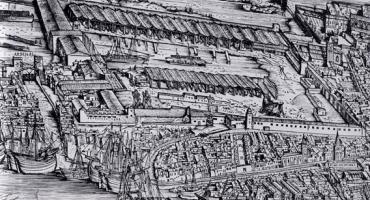History saddles Venice, a city so rich of artistic and architectural treasures of the past, that seems not to be suited to offer spaces to contemporary art at all and yet it was just there in 1895 the first International Art Exposition of Venice, after becoming the Biennale of Venice.
From the first edition, the exposition was set up in Giardini, when in winter 1894 was built the Padiglione Italia, under the design of the architect Enrico Trevisanato, while the neoclassical façade was by the Venetian painter Marius De Maria.
Between 1907 and 1914 some national Pavillions were built: Belgian, German, French, British, Hungarian and Russian. Others were built in the following years and it is the eclecticism of the architectural styles, some of which recall the traditional architecture of the relative country, to make the Biennale Gardens a place of charm and its shabby look increases it.
From the ’90 some areas of the Arsenal were used as exposition spaces for the Biennale, in particular the Corderie, where once they used to make ship ropes, and the Tese, where sails were organized. The Arsenal, together with the Padiglione Italia became the place where superintendents present the artists they chose, while the artists exhibiting on the different national Pavillions are chosen by Culture Ministry of the relative countries (www.labiennale.org).
Coming back on foot from Saint Mark’s Square, along the Riva degli Schiavoni you meet one of the most important organization for contemporary art: Fondazione Bevilacqua La Masa (www.bevilacqualamasa.it), located just under the portico of Procuratie Nuove, near the Correr Museum. This Foundation was established in 1989 thanks the Dutchess Felicita Bevilacqua La Masa, who left Venice Municipality her palace on the Grand Canal, Ca’ Pesaro, only if it would have become a place for artistic culture. From 1908 to 1924 the mezzanine floor rooms became the office of new talent expositions arranged by Nino Barbantini. During these expositions, some of the most important Italian artists, such as Arturo Martini and the painters Gino Rossi, Umberto Moggioli and Felice Casorati.
Hereafter, Ca’ Pesaro became the office of the Modern Art Gallery and now there are works of big Italian and foreign artists such as Chagall, Kandinsky, Morandi, De Chirico, Jean Arp, Moore, Max Ernst, Alexander Calder (www.museiciviciveneziani.it).
Instead, the Foundation moved to Saint Mark’s Square, where since 1999 –year of its centenary – exhibited important shows of contemporary artists, such as Jean-Michel Basquiat, Louise Bourgeois, Milton Glaser, Shirin Neshat, Kim Sooja.
Palazzetto Tito, a secondary office, is located between Saint Barnaba’s Square and Saint Margherita’s Square. This is the office for young artists, with whom the Foundation continues its mission of enhancing and supporting rising artists.
Every year a competition announcement is published, to all young artists living or domiciled in Triveneto to take part in a collective exhibition, set up in the Foundation. Scholarships and special awards are given to the winners together with the possibility to work in an atelier for one year. Even ateliers, that now are in the ex-cloister SS. Cosma e Damiano and in Giudecca island, become sometimes places for expositions where artists show public their works.
The area around Saint Mark’s Square is historically the place for many art galleries: the gallery of Michela Rizzo (www.galleriamichelarizzo.net), with works of young successful artists such as the Russian Serghey Shutov, the Korean Soyeon Cho, the American Lawrence Carroll, together with a quite big group of Italian artists.
Next to La Fenice Theatre there is the Galerie Bordas, specialized in graphic, which presents original printings of artists the likes of Zoran Music, Dubuffet, Mirò, Picasso, Mimmo Paladino ed Enrico Baj (www.galeriebordas.com).
In Santo Stefano Square the historical Venetian gallery Galleria S. Stefano, founded in 1949 by Giorgio Zamberlan and now ran by his nephew Roberto; here De Chirico, close friend to the owner, showed every year his works. In this gallery, among others, exhibited De Pisis, Morandi and Sironi (www.galleriasantostefano.it). These artists have been essential for the city’s artistic life and the gallery had an important role for artist generations who stopped in Venice, such as Vedova, Santomaso, Pizzinato, Gianquinto since here they could ask the masters an advice.
From San Samuele Square, the eighteen-century Palazzo Grassi (http://www.palazzograssi.it/), office of many exhibitions, was recently reopened after being bought by the French tycoon François Pinault, who chose the palace as exhibition center for his extended contemporary art collection.
Then, again in Santo Stefano Square, the Venetian Institute for Science, Literature and Arts exhibits for some years and offers activity linked to contemporary art, such as the glass exhibition, in which creations by some young artists and designers all over the world were showed. The Institute also hosts arts conferences and conventions.
Then, again in Santo Stefano Square, the Venetian Institute for Science, Literature and Arts exhibits for some years and offers activity linked to contemporary art, such as the glass exhibition, in which creations by some young artists and designers all over the world were showed. The Institute also hosts arts conferences and conventions.(www.istitutoveneto.it).
After the Accademia Bridge, the Palazzo Venier dei Leoni, now head office of Peggy Guggenheim Collection (www.guggenheim-venice.it). It is here in this palace that Peggy, Solomon R. Guggenheim’s nephew took his private collection started during the war and carried on through years through a real form of contemporary patronage. The collection includes works by Picasso, Max Ernst, Calder, Mirò e Pollock. In the gardens, sculptures by Max Ernst, Giacometti, Jean Arp, Mario Merz, Henry Moore, and Anthony Caro, partly from Peggy’s collection and partly from the Raymond and Patsy Nasher Sculpture Collection in Dallas, Texas. Over recent years, the museum hosts some important works by Italian artists (Carrà, Sironi, Morandi, Balla, Boccioni) from the collection of Gianni Mattioli. The Guggenheim also regularly hosts temporary exhibitions. Anyway, it has a spectacular view over the canal from the terrace, just like a floating raft in the heart of the city, and from here you can imagine Peggy talking with one of the many artists dropping by ….



